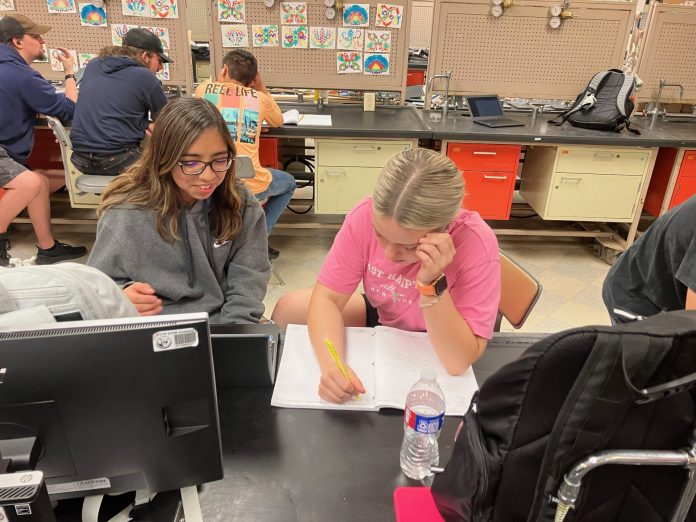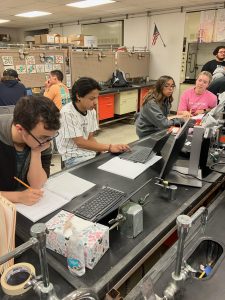
A program that STEM Academy teachers and administrators started researching about a year ago has come to life at the campus through a grant from the Education Foundation.
Awardees are Curriculum Director Candice Sikes, Executive Director Shannon Davidson and high school Project Lead the Way teacher Karey Grametbaur. The $12,000 grant is called Unlocking the Secrets of the Brain.
Davidson said she and Grametbaur heard about it at different times, but both thought it would be great for the STEM Academy.
When they heard about the Education Foundation grant opportunity, they thought that was a good time to go for it.
Grametbaur said part of it is a VR headset that has been programmed with parts and pieces of the brain, so when students put it on they’re able to see the brain itself in 3D. Students will learn how to compare the size of a human brain compared to a rat brain, for example.
The program to look at the brain was developed by syGlass. Its website says syGlass software “allows you to view your data in its actual 3D or 4D (over time) form through virtual reality.”
“We teach them how to use the VR headset as the tool in neuroscience. We go through several lessons like that where they’re using the VR headset as a tool. The whole neuroscience field is the brain, the spinal cord, the nerves, how it looks, how the neurons work. We look at all of that through that 3D VR headset,” Grametbaur said.
“The cool thing is, even though we only have a certain amount of VR headsets, it’s cast on a big monitor. If you’re chosen that day to be wearing it, the other two or three students that are with you can still see the monitor. They’re seeing everything that you’re seeing. It’s just that that particular day, one person is manipulating the controls. They can switch off to who does the controlling part of it, but everybody in the class can see it,” she added.
Starting around January, the second part of the grant, Citizen Science, will be implemented.
“This is when we pair up with a professor that’s doing research on neuroscience and the way that the brain works. He dials in with them through the VR headset multiple times a week during our class period. He’s showing them this is my research. I need you to help me conduct my research; he teaches the students how to read neurotransmitters; how it looks when you’re moving and manipulating certain things; how they change when you’re sleeping and awake. … He teaches them how to do that. He’s actually a research scientist at a university that’s doing his own neuroscience research. He’s using them as interns sort of … He spends quite a bit of time with them, showing them that process; showing them how to do that field work; how to put data down; how to read the data. Basically, how to answer the hypothesis that he’s … researching for that year,” Grametbaur said.
The students will be authors on the paper that the professor writes because they’ve helped him research it.

The class, which is Grametbaur’s senior level capstone course, includes all three pathways that STEM offers — neuroscience, computer programming and engineering. She added that they complement each other.
“This really does a good job of showing them that even though technically we’re talking about neuroscience, which is a biomedical pathway, we’re also looking at the VR headset as an engineering invention and how that works, but also the programming that goes behind the VR headset is something that our programmers would be interested in, or could be interested in,” Grametbaur said.
Davidson said they wrote the grant with two University of Texas Permian Basin professors, Kara Rosenblatt and Haidee Jackson, who wanted to conduct research on the effects of virtual reality on learning. They want to see if it improves retention rates and they’re looking at student engagement to see how VR will improve that.
The proposal will be submitted to the Institutional Review Board.
Grametbaur said this will bring students real-life, hands-on experience.
“This is something they’re truly a part of, the professor is counting on them to help with his research, and that makes it very relevant to them,” she added.
Grametbaur said there are a lot of careers connected to VR. It’s the way things are going in education, it’s hands-on and it’s relevant.
“I’m excited to see how our three pathways at STEM, now that they’ve had the three years of individualized education almost, how they see how the other pathways can support and enhance their projects moving forward that they can pull the strings from each of their pathways,” Sikes said.
Davidson said the students have been traveling with their engineering, computer programming or biomedical science peers and now they’re working together.
”They’ve created their own little cohorts,” Sikes said, “just like a university would have a College of Ed(ucation) or College of Engineering, they’ve become very comfortable. I’m really curious to see how they blend and collaborate together and see how they can benefit one another.”
Sikes, Davidson and Grametbaur said they were grateful to the Education Foundation for providing this chance.
“I don’t know that this would have been the year for us if they hadn’t been able to provide the grant. It was the direction we’ve been wanting to go, like has already (been) mentioned, but the grant allows us to make that happen sooner,” Sikes said.
They added that they would encourage others to apply for Foundation grants.
“I think it’s a great way to bring innovative ideas to the campuses and to try things that you normally wouldn’t do because sometimes you just don’t have the budget to try these different things. It was a perfect opportunity to bring that innovative piece that I just think helps take our learning further into the next level with our students,” Davidson said.
Grametbaur said they are always “striving for relevant learning.”
“Like I said, the older they get, the harder it is to reach that,” she added.
Davidson said the fun thing about Grametbaur is that she’s always willing to take on a new challenge.
“She always says, I don’t know how to do this, but I can learn right along with the kids. That’s kind of what this class has been,” Davidson said.
She added that it’s exciting to have a teacher who is willing to go outside their comfort zone and learn and grow with the students.
“I just think we lucked out with Ms. Grametbaur. She’s amazing. I think that none of this would have been possible without her to make sure that this goes in the right way. She’ll do the whole class in the curriculum justice, and those kids are in for a huge treat this year,” Davidson said.



